Arab Open University: Team Conflict Dynamic Modelling Report (SYS280)
VerifiedAdded on 2022/08/28
|12
|3328
|17
Report
AI Summary
This report delves into the complexities of team conflict within a five-member team, focusing on the application of system dynamic modeling to facilitate resolution. The analysis explores the use of double-loop feedback learning structures to improve interactions and system relationships, acknowle...
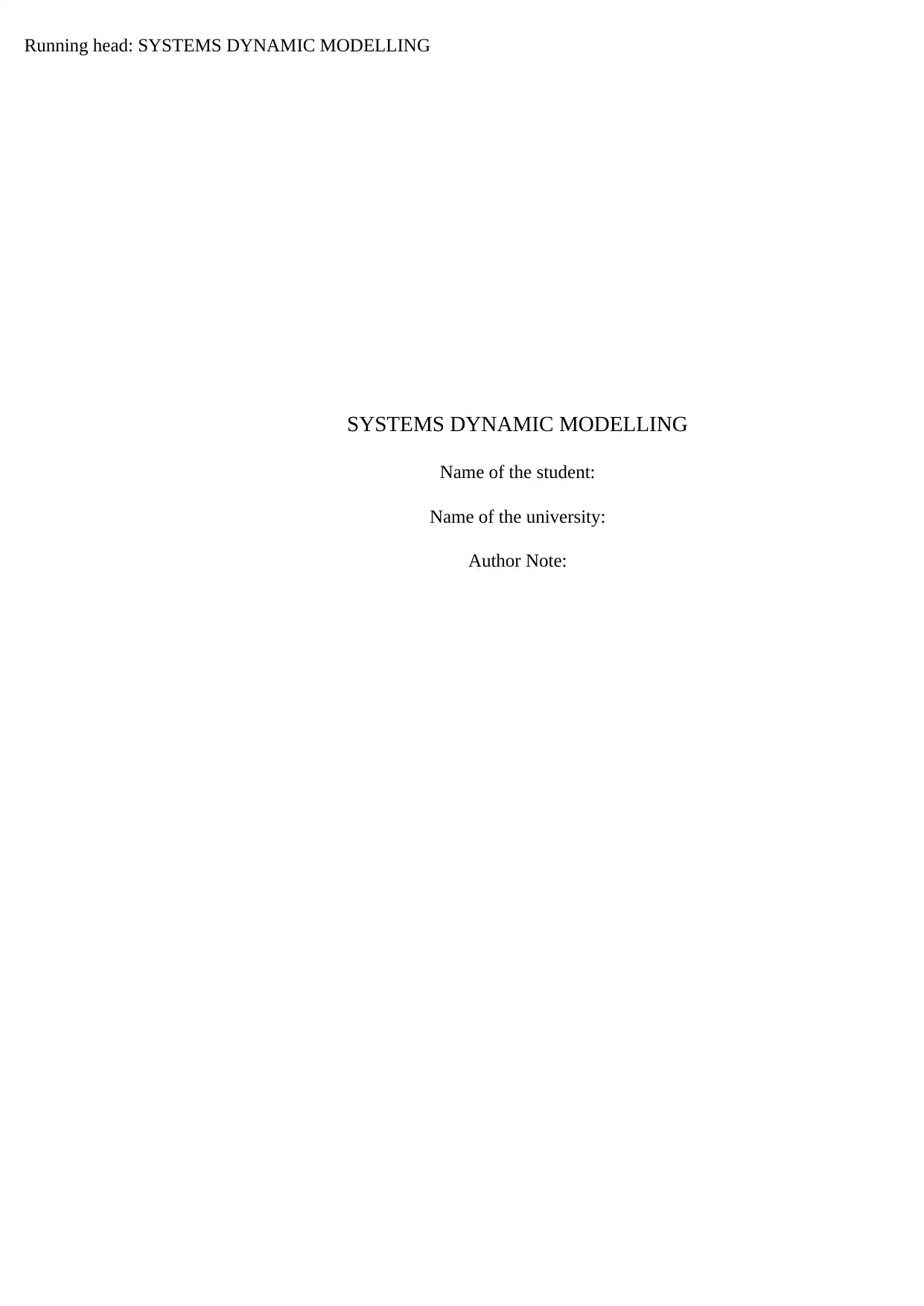
Running head: SYSTEMS DYNAMIC MODELLING
SYSTEMS DYNAMIC MODELLING
Name of the student:
Name of the university:
Author Note:
SYSTEMS DYNAMIC MODELLING
Name of the student:
Name of the university:
Author Note:
Paraphrase This Document
Need a fresh take? Get an instant paraphrase of this document with our AI Paraphraser

1SYSTEMS DYNAMIC MODELLING
Executive summary
The paper talks about the team conflict problem in the team of five members. The team
conflict resolution is the main area of discussion here. Due to which system dynamic
modelling is used with the double loop feedback and learning structure in order to make the
interactions and the system relationships better. The dynamic model used can suffer from
limitations like the non-linear relationships among the element, time delays in top
management decisions and the private agendas of team. The practical application of the
dynamic model cannot be possible with these limitations, due to which the virtual simulation
model is used through role plays and games to reduce time conflict.
Executive summary
The paper talks about the team conflict problem in the team of five members. The team
conflict resolution is the main area of discussion here. Due to which system dynamic
modelling is used with the double loop feedback and learning structure in order to make the
interactions and the system relationships better. The dynamic model used can suffer from
limitations like the non-linear relationships among the element, time delays in top
management decisions and the private agendas of team. The practical application of the
dynamic model cannot be possible with these limitations, due to which the virtual simulation
model is used through role plays and games to reduce time conflict.
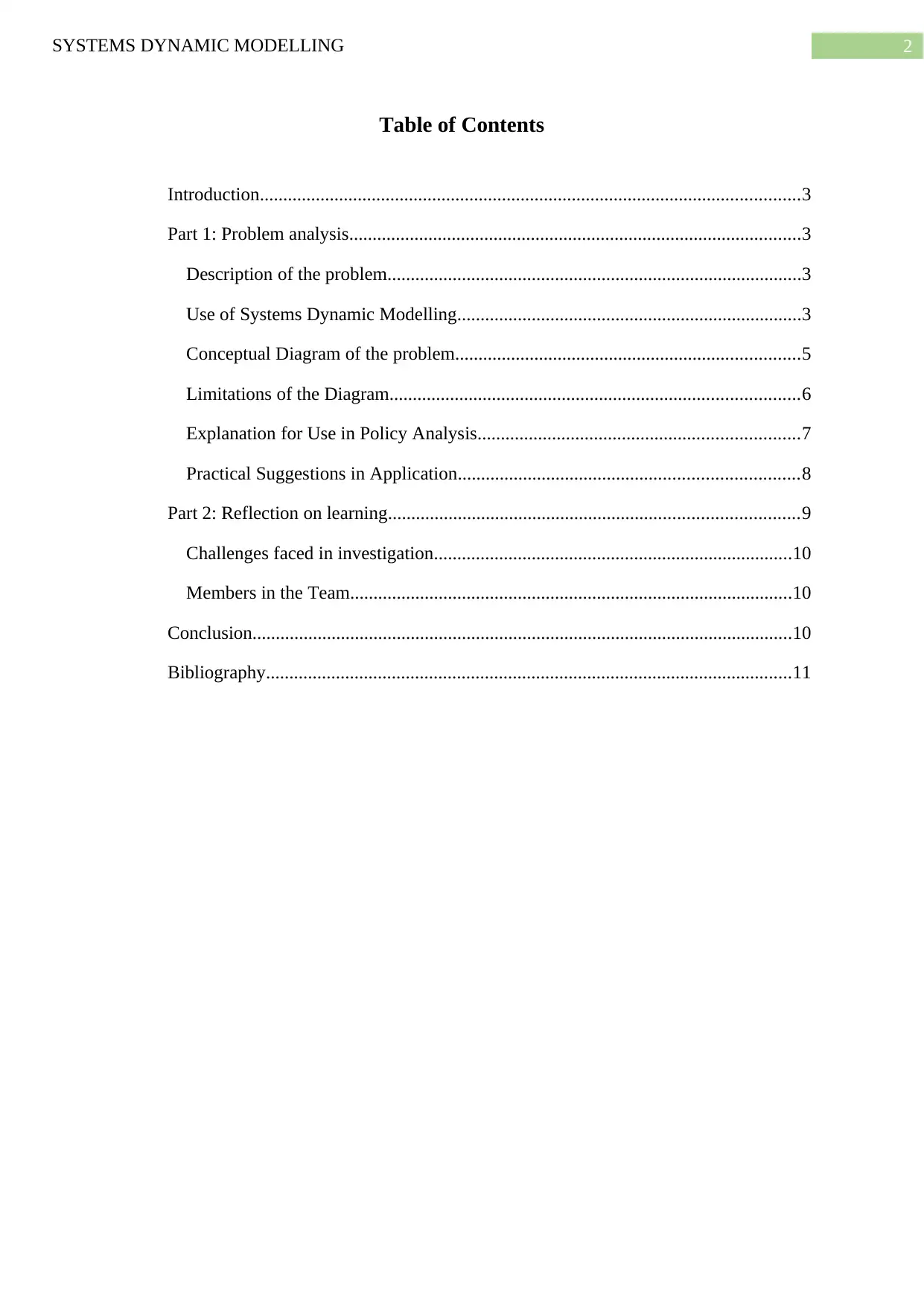
2SYSTEMS DYNAMIC MODELLING
Table of Contents
Introduction....................................................................................................................3
Part 1: Problem analysis.................................................................................................3
Description of the problem.........................................................................................3
Use of Systems Dynamic Modelling..........................................................................3
Conceptual Diagram of the problem..........................................................................5
Limitations of the Diagram........................................................................................6
Explanation for Use in Policy Analysis.....................................................................7
Practical Suggestions in Application.........................................................................8
Part 2: Reflection on learning........................................................................................9
Challenges faced in investigation.............................................................................10
Members in the Team...............................................................................................10
Conclusion....................................................................................................................10
Bibliography.................................................................................................................11
Table of Contents
Introduction....................................................................................................................3
Part 1: Problem analysis.................................................................................................3
Description of the problem.........................................................................................3
Use of Systems Dynamic Modelling..........................................................................3
Conceptual Diagram of the problem..........................................................................5
Limitations of the Diagram........................................................................................6
Explanation for Use in Policy Analysis.....................................................................7
Practical Suggestions in Application.........................................................................8
Part 2: Reflection on learning........................................................................................9
Challenges faced in investigation.............................................................................10
Members in the Team...............................................................................................10
Conclusion....................................................................................................................10
Bibliography.................................................................................................................11
⊘ This is a preview!⊘
Do you want full access?
Subscribe today to unlock all pages.

Trusted by 1+ million students worldwide
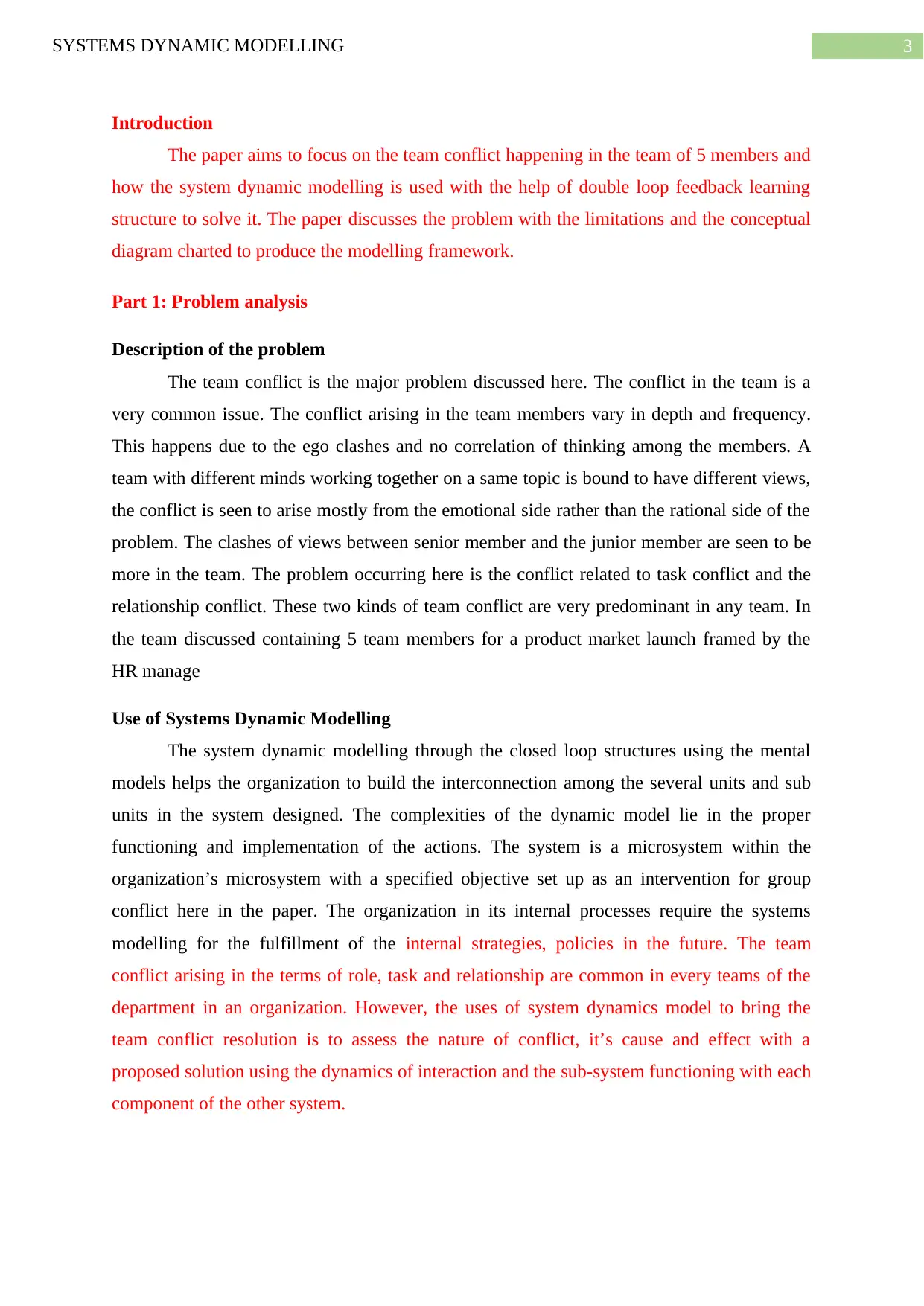
3SYSTEMS DYNAMIC MODELLING
Introduction
The paper aims to focus on the team conflict happening in the team of 5 members and
how the system dynamic modelling is used with the help of double loop feedback learning
structure to solve it. The paper discusses the problem with the limitations and the conceptual
diagram charted to produce the modelling framework.
Part 1: Problem analysis
Description of the problem
The team conflict is the major problem discussed here. The conflict in the team is a
very common issue. The conflict arising in the team members vary in depth and frequency.
This happens due to the ego clashes and no correlation of thinking among the members. A
team with different minds working together on a same topic is bound to have different views,
the conflict is seen to arise mostly from the emotional side rather than the rational side of the
problem. The clashes of views between senior member and the junior member are seen to be
more in the team. The problem occurring here is the conflict related to task conflict and the
relationship conflict. These two kinds of team conflict are very predominant in any team. In
the team discussed containing 5 team members for a product market launch framed by the
HR manage
Use of Systems Dynamic Modelling
The system dynamic modelling through the closed loop structures using the mental
models helps the organization to build the interconnection among the several units and sub
units in the system designed. The complexities of the dynamic model lie in the proper
functioning and implementation of the actions. The system is a microsystem within the
organization’s microsystem with a specified objective set up as an intervention for group
conflict here in the paper. The organization in its internal processes require the systems
modelling for the fulfillment of the internal strategies, policies in the future. The team
conflict arising in the terms of role, task and relationship are common in every teams of the
department in an organization. However, the uses of system dynamics model to bring the
team conflict resolution is to assess the nature of conflict, it’s cause and effect with a
proposed solution using the dynamics of interaction and the sub-system functioning with each
component of the other system.
Introduction
The paper aims to focus on the team conflict happening in the team of 5 members and
how the system dynamic modelling is used with the help of double loop feedback learning
structure to solve it. The paper discusses the problem with the limitations and the conceptual
diagram charted to produce the modelling framework.
Part 1: Problem analysis
Description of the problem
The team conflict is the major problem discussed here. The conflict in the team is a
very common issue. The conflict arising in the team members vary in depth and frequency.
This happens due to the ego clashes and no correlation of thinking among the members. A
team with different minds working together on a same topic is bound to have different views,
the conflict is seen to arise mostly from the emotional side rather than the rational side of the
problem. The clashes of views between senior member and the junior member are seen to be
more in the team. The problem occurring here is the conflict related to task conflict and the
relationship conflict. These two kinds of team conflict are very predominant in any team. In
the team discussed containing 5 team members for a product market launch framed by the
HR manage
Use of Systems Dynamic Modelling
The system dynamic modelling through the closed loop structures using the mental
models helps the organization to build the interconnection among the several units and sub
units in the system designed. The complexities of the dynamic model lie in the proper
functioning and implementation of the actions. The system is a microsystem within the
organization’s microsystem with a specified objective set up as an intervention for group
conflict here in the paper. The organization in its internal processes require the systems
modelling for the fulfillment of the internal strategies, policies in the future. The team
conflict arising in the terms of role, task and relationship are common in every teams of the
department in an organization. However, the uses of system dynamics model to bring the
team conflict resolution is to assess the nature of conflict, it’s cause and effect with a
proposed solution using the dynamics of interaction and the sub-system functioning with each
component of the other system.
Paraphrase This Document
Need a fresh take? Get an instant paraphrase of this document with our AI Paraphraser
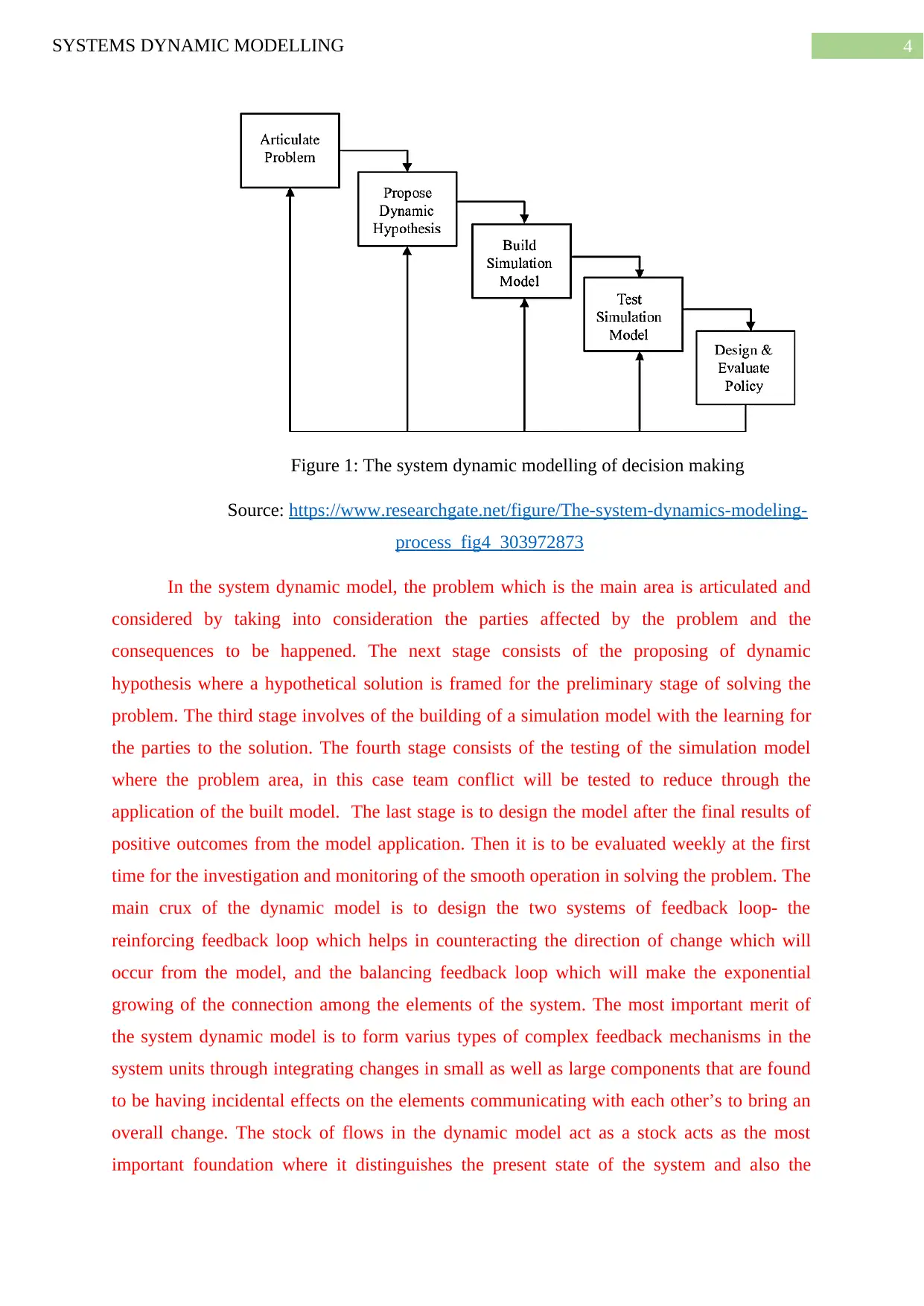
4SYSTEMS DYNAMIC MODELLING
Figure 1: The system dynamic modelling of decision making
Source: https://www.researchgate.net/figure/The-system-dynamics-modeling-
process_fig4_303972873
In the system dynamic model, the problem which is the main area is articulated and
considered by taking into consideration the parties affected by the problem and the
consequences to be happened. The next stage consists of the proposing of dynamic
hypothesis where a hypothetical solution is framed for the preliminary stage of solving the
problem. The third stage involves of the building of a simulation model with the learning for
the parties to the solution. The fourth stage consists of the testing of the simulation model
where the problem area, in this case team conflict will be tested to reduce through the
application of the built model. The last stage is to design the model after the final results of
positive outcomes from the model application. Then it is to be evaluated weekly at the first
time for the investigation and monitoring of the smooth operation in solving the problem. The
main crux of the dynamic model is to design the two systems of feedback loop- the
reinforcing feedback loop which helps in counteracting the direction of change which will
occur from the model, and the balancing feedback loop which will make the exponential
growing of the connection among the elements of the system. The most important merit of
the system dynamic model is to form varius types of complex feedback mechanisms in the
system units through integrating changes in small as well as large components that are found
to be having incidental effects on the elements communicating with each other’s to bring an
overall change. The stock of flows in the dynamic model act as a stock acts as the most
important foundation where it distinguishes the present state of the system and also the
Figure 1: The system dynamic modelling of decision making
Source: https://www.researchgate.net/figure/The-system-dynamics-modeling-
process_fig4_303972873
In the system dynamic model, the problem which is the main area is articulated and
considered by taking into consideration the parties affected by the problem and the
consequences to be happened. The next stage consists of the proposing of dynamic
hypothesis where a hypothetical solution is framed for the preliminary stage of solving the
problem. The third stage involves of the building of a simulation model with the learning for
the parties to the solution. The fourth stage consists of the testing of the simulation model
where the problem area, in this case team conflict will be tested to reduce through the
application of the built model. The last stage is to design the model after the final results of
positive outcomes from the model application. Then it is to be evaluated weekly at the first
time for the investigation and monitoring of the smooth operation in solving the problem. The
main crux of the dynamic model is to design the two systems of feedback loop- the
reinforcing feedback loop which helps in counteracting the direction of change which will
occur from the model, and the balancing feedback loop which will make the exponential
growing of the connection among the elements of the system. The most important merit of
the system dynamic model is to form varius types of complex feedback mechanisms in the
system units through integrating changes in small as well as large components that are found
to be having incidental effects on the elements communicating with each other’s to bring an
overall change. The stock of flows in the dynamic model act as a stock acts as the most
important foundation where it distinguishes the present state of the system and also the
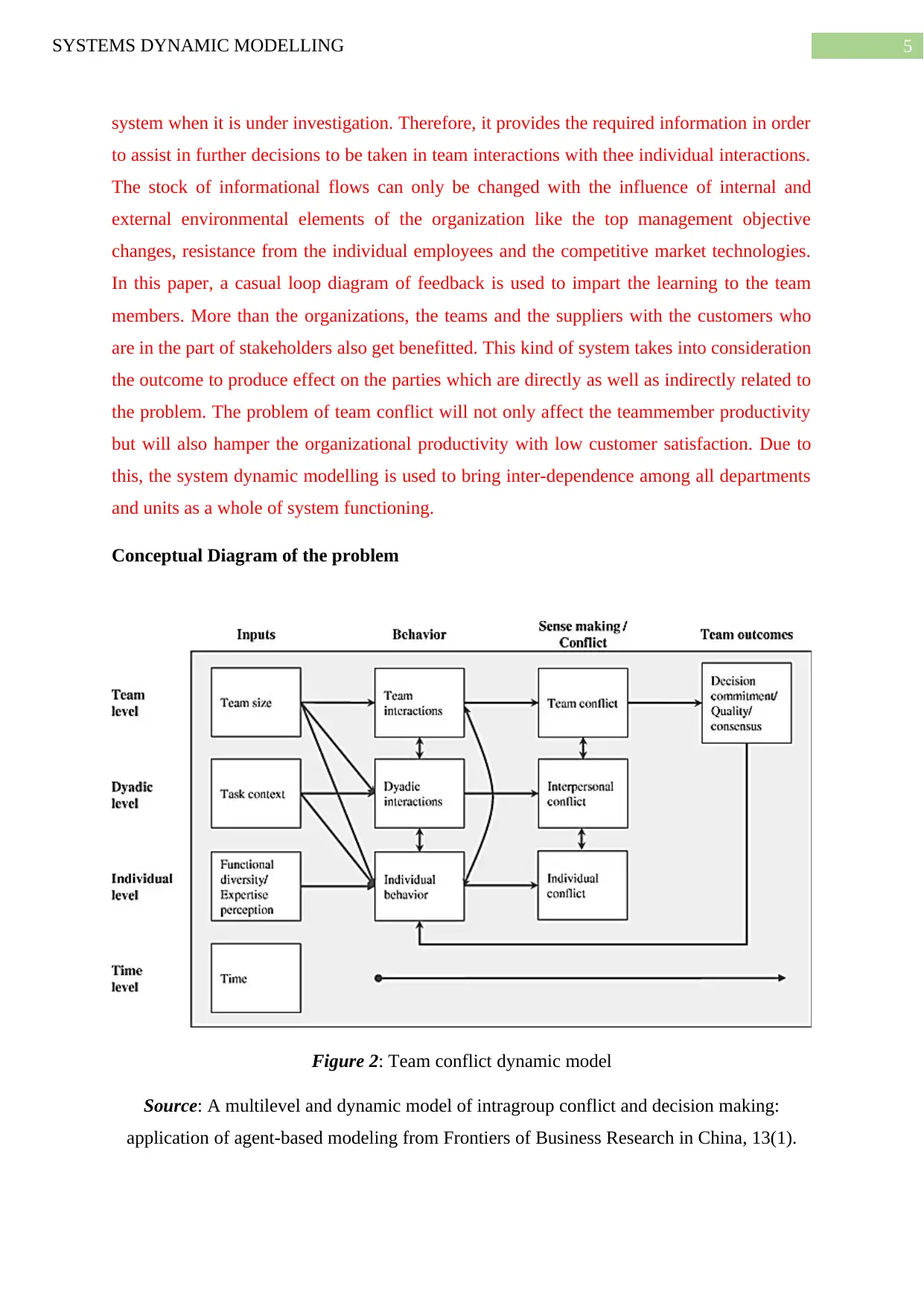
5SYSTEMS DYNAMIC MODELLING
system when it is under investigation. Therefore, it provides the required information in order
to assist in further decisions to be taken in team interactions with thee individual interactions.
The stock of informational flows can only be changed with the influence of internal and
external environmental elements of the organization like the top management objective
changes, resistance from the individual employees and the competitive market technologies.
In this paper, a casual loop diagram of feedback is used to impart the learning to the team
members. More than the organizations, the teams and the suppliers with the customers who
are in the part of stakeholders also get benefitted. This kind of system takes into consideration
the outcome to produce effect on the parties which are directly as well as indirectly related to
the problem. The problem of team conflict will not only affect the teammember productivity
but will also hamper the organizational productivity with low customer satisfaction. Due to
this, the system dynamic modelling is used to bring inter-dependence among all departments
and units as a whole of system functioning.
Conceptual Diagram of the problem
Figure 2: Team conflict dynamic model
Source: A multilevel and dynamic model of intragroup conflict and decision making:
application of agent-based modeling from Frontiers of Business Research in China, 13(1).
system when it is under investigation. Therefore, it provides the required information in order
to assist in further decisions to be taken in team interactions with thee individual interactions.
The stock of informational flows can only be changed with the influence of internal and
external environmental elements of the organization like the top management objective
changes, resistance from the individual employees and the competitive market technologies.
In this paper, a casual loop diagram of feedback is used to impart the learning to the team
members. More than the organizations, the teams and the suppliers with the customers who
are in the part of stakeholders also get benefitted. This kind of system takes into consideration
the outcome to produce effect on the parties which are directly as well as indirectly related to
the problem. The problem of team conflict will not only affect the teammember productivity
but will also hamper the organizational productivity with low customer satisfaction. Due to
this, the system dynamic modelling is used to bring inter-dependence among all departments
and units as a whole of system functioning.
Conceptual Diagram of the problem
Figure 2: Team conflict dynamic model
Source: A multilevel and dynamic model of intragroup conflict and decision making:
application of agent-based modeling from Frontiers of Business Research in China, 13(1).
⊘ This is a preview!⊘
Do you want full access?
Subscribe today to unlock all pages.

Trusted by 1+ million students worldwide

6SYSTEMS DYNAMIC MODELLING
In this model we can see that the team conflict depends on certain inputs like the size
of team, the task context and the roles on which the team members are working, the amount
of expertise of skills each team member is possessing and lastly the time. The time here is
divided into both the individual time taken by the team member to contribute to the team and
the time taken by the team as a whole to complete the tasks. The team size depends on the
interactions of the team as a whole as well as the team behavior in the team. The dyadic
interactions with the team members, their individual units of department and the management
communication. The task content depends only on the dyadic interactions happening across
the team and the individual behavior of the team. The individual expertise of functions
depend on the individual behavior of the member. From the team level, we can that through
team interactions, team size – the team conflict arises. From the dyadic level, the team task
contexts as well the whole dyadic communications make the interpersonal conflict. The
individual conflict depends on the individual behavior and the expertise perception of the
member himself or herself. In the behavior element, all the team and dydaic as well the
individual behavior interactions are inter-related with each other. All these three interactions
together create the overall conflict model. From the team level, with the input of team size,
team interactions and the team conflict- the team outcome of final decision or the quality
consensus is decided. However, the team outcomes is decided on the individual behavior
itself. The time as the general element sets the basic foundational base. It controls the overall
functioning of the conflict and the team activities with the rise of conflict and the solution
devised to end the conflict. The overall diagram states that the conflict is based on certain
elements and these elements together in a collaborative way. The levels of conflict are
different and are in a hierarchical level but the levels are interconnected. The conflict does
not arise alone.
Limitations of the Diagram
a. The complexity of the diagram lies in the tightly closed relationships among the team
conflict with interpersonal and individual conflict.
b. The reality of the team outcomes through proposed solutions in order to bring team
conflict-resolution can fail to implement properly due to the distortion of organizational
processes and the delay in decisions of top management.
c. Throughout a system, the asymmetric information with agendas set privately can interrupt
the flow of interaction among the elements.
In this model we can see that the team conflict depends on certain inputs like the size
of team, the task context and the roles on which the team members are working, the amount
of expertise of skills each team member is possessing and lastly the time. The time here is
divided into both the individual time taken by the team member to contribute to the team and
the time taken by the team as a whole to complete the tasks. The team size depends on the
interactions of the team as a whole as well as the team behavior in the team. The dyadic
interactions with the team members, their individual units of department and the management
communication. The task content depends only on the dyadic interactions happening across
the team and the individual behavior of the team. The individual expertise of functions
depend on the individual behavior of the member. From the team level, we can that through
team interactions, team size – the team conflict arises. From the dyadic level, the team task
contexts as well the whole dyadic communications make the interpersonal conflict. The
individual conflict depends on the individual behavior and the expertise perception of the
member himself or herself. In the behavior element, all the team and dydaic as well the
individual behavior interactions are inter-related with each other. All these three interactions
together create the overall conflict model. From the team level, with the input of team size,
team interactions and the team conflict- the team outcome of final decision or the quality
consensus is decided. However, the team outcomes is decided on the individual behavior
itself. The time as the general element sets the basic foundational base. It controls the overall
functioning of the conflict and the team activities with the rise of conflict and the solution
devised to end the conflict. The overall diagram states that the conflict is based on certain
elements and these elements together in a collaborative way. The levels of conflict are
different and are in a hierarchical level but the levels are interconnected. The conflict does
not arise alone.
Limitations of the Diagram
a. The complexity of the diagram lies in the tightly closed relationships among the team
conflict with interpersonal and individual conflict.
b. The reality of the team outcomes through proposed solutions in order to bring team
conflict-resolution can fail to implement properly due to the distortion of organizational
processes and the delay in decisions of top management.
c. Throughout a system, the asymmetric information with agendas set privately can interrupt
the flow of interaction among the elements.
Paraphrase This Document
Need a fresh take? Get an instant paraphrase of this document with our AI Paraphraser

7SYSTEMS DYNAMIC MODELLING
d. The individuals may resist certain solutions due to the fear of their security of functional
knowledge and job duties. There can be time delays in the systems channel which can
create instability.
e. The dependence of each path of the element with another element can be disturbed if the
self-organization of conflict arise among the units of individual level. The dynamics can
get disturbed in the internal system.
f. A non-linear relationship exists within the systems where the effect is not to so
proportional to the cause. The cause of one starting point can be non-proportional to
effect of another point in the destination due to the non-linearity which is bound to occur
among the multiple factors within a system unit at a particular level.
Explanation for Use in Policy Analysis
Although the complexity of the model drawn above is filled with limitations, yet a
different strategy is required in order to implement it. The failure of implementation of the
model will make the team conflict stagnant in the organization.
It can be used through a reframed simulation technique formulated by Fred’s
intervention. It is the double-loop learning model structure on which the system model
diagram can be used in framing the policy. The information feedback system in the model not
only will alter the decisions taken within the context of all the pre-existing frames but as well
as the decision rules will help in providing feedback in order to alter the mental model. The
mental model as designed will totally change as the structure in-built in the system will be
changed by creating the different decision rules as well as the new strategies to be framed in
better team conflict resolution. The same information which will be processed and in a way
interpreted by a different kind of decision rule will now yields a different re-framed decision.
Thus, the altering of the structure of system will also alter the patterns of behavior as found
among the team and the individuals across the system channel. The development of systems
thinking is thus, a double-loop learning process system model in which there will be
replacement of a narrow and short run as well as static view of the reality with a broad, long
term and flexible view, therefore by redefining the policies and instructions accordingly.
d. The individuals may resist certain solutions due to the fear of their security of functional
knowledge and job duties. There can be time delays in the systems channel which can
create instability.
e. The dependence of each path of the element with another element can be disturbed if the
self-organization of conflict arise among the units of individual level. The dynamics can
get disturbed in the internal system.
f. A non-linear relationship exists within the systems where the effect is not to so
proportional to the cause. The cause of one starting point can be non-proportional to
effect of another point in the destination due to the non-linearity which is bound to occur
among the multiple factors within a system unit at a particular level.
Explanation for Use in Policy Analysis
Although the complexity of the model drawn above is filled with limitations, yet a
different strategy is required in order to implement it. The failure of implementation of the
model will make the team conflict stagnant in the organization.
It can be used through a reframed simulation technique formulated by Fred’s
intervention. It is the double-loop learning model structure on which the system model
diagram can be used in framing the policy. The information feedback system in the model not
only will alter the decisions taken within the context of all the pre-existing frames but as well
as the decision rules will help in providing feedback in order to alter the mental model. The
mental model as designed will totally change as the structure in-built in the system will be
changed by creating the different decision rules as well as the new strategies to be framed in
better team conflict resolution. The same information which will be processed and in a way
interpreted by a different kind of decision rule will now yields a different re-framed decision.
Thus, the altering of the structure of system will also alter the patterns of behavior as found
among the team and the individuals across the system channel. The development of systems
thinking is thus, a double-loop learning process system model in which there will be
replacement of a narrow and short run as well as static view of the reality with a broad, long
term and flexible view, therefore by redefining the policies and instructions accordingly.

8SYSTEMS DYNAMIC MODELLING
Figure: Double loop learning structure
Source:
In system dynamics, the feedback is one of the important decision criteria of the
functioning of the model. If taken the single loop feedback model, where the elements
decisions, real world and the information feedback are inter-connected with each other. The
strategy, structure and the decision rules are connected to decisions and the mental models
are connected to strategy and structures. However, more the single loop, the double loop
learning feedback structure is better. The system dynamics arise from feedback, therefore the
team learning will depend on the feedback model. The decisions should be made in such a
way that it alters the real world and it also helps to gather the information feedback from the
real operating systems and use that information to restructure the faulty system unit patterns
of interaction with newly framed strategies, decisions and systems. In the system dynamics,
the adoption of mental model includes the beliefs and the behavioral values about the
networks which gives rise to the causes and effects describing that how a system operates,
along with the aspects of the boundary of the model where certain variable are included and
certain variables are excluded. The time horizon considered helps in reframing the
articulation of the problem of team conflict here for example.
Practical Suggestions in Application
The double loop learning structure for feedback system as discussed for policy
implementation in the mitigation of the problem is not a smooth operation. In reality, there
are a lot of obstacles in the way of practical implementation. The feedback learning structure
is actually a shape of the Kanizsa triangle where the active and unconscious mental modelling
Figure: Double loop learning structure
Source:
In system dynamics, the feedback is one of the important decision criteria of the
functioning of the model. If taken the single loop feedback model, where the elements
decisions, real world and the information feedback are inter-connected with each other. The
strategy, structure and the decision rules are connected to decisions and the mental models
are connected to strategy and structures. However, more the single loop, the double loop
learning feedback structure is better. The system dynamics arise from feedback, therefore the
team learning will depend on the feedback model. The decisions should be made in such a
way that it alters the real world and it also helps to gather the information feedback from the
real operating systems and use that information to restructure the faulty system unit patterns
of interaction with newly framed strategies, decisions and systems. In the system dynamics,
the adoption of mental model includes the beliefs and the behavioral values about the
networks which gives rise to the causes and effects describing that how a system operates,
along with the aspects of the boundary of the model where certain variable are included and
certain variables are excluded. The time horizon considered helps in reframing the
articulation of the problem of team conflict here for example.
Practical Suggestions in Application
The double loop learning structure for feedback system as discussed for policy
implementation in the mitigation of the problem is not a smooth operation. In reality, there
are a lot of obstacles in the way of practical implementation. The feedback learning structure
is actually a shape of the Kanizsa triangle where the active and unconscious mental modelling
⊘ This is a preview!⊘
Do you want full access?
Subscribe today to unlock all pages.

Trusted by 1+ million students worldwide
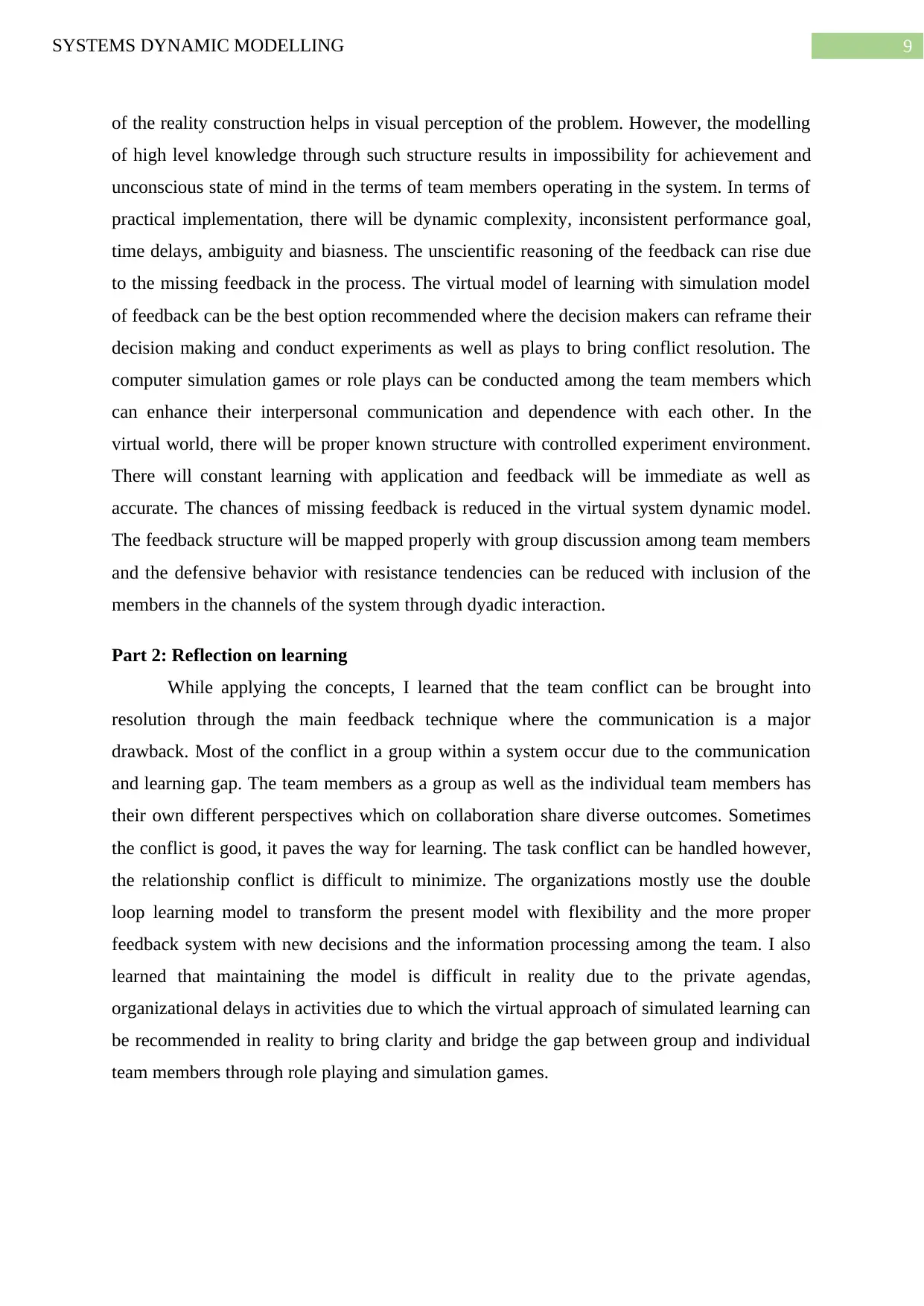
9SYSTEMS DYNAMIC MODELLING
of the reality construction helps in visual perception of the problem. However, the modelling
of high level knowledge through such structure results in impossibility for achievement and
unconscious state of mind in the terms of team members operating in the system. In terms of
practical implementation, there will be dynamic complexity, inconsistent performance goal,
time delays, ambiguity and biasness. The unscientific reasoning of the feedback can rise due
to the missing feedback in the process. The virtual model of learning with simulation model
of feedback can be the best option recommended where the decision makers can reframe their
decision making and conduct experiments as well as plays to bring conflict resolution. The
computer simulation games or role plays can be conducted among the team members which
can enhance their interpersonal communication and dependence with each other. In the
virtual world, there will be proper known structure with controlled experiment environment.
There will constant learning with application and feedback will be immediate as well as
accurate. The chances of missing feedback is reduced in the virtual system dynamic model.
The feedback structure will be mapped properly with group discussion among team members
and the defensive behavior with resistance tendencies can be reduced with inclusion of the
members in the channels of the system through dyadic interaction.
Part 2: Reflection on learning
While applying the concepts, I learned that the team conflict can be brought into
resolution through the main feedback technique where the communication is a major
drawback. Most of the conflict in a group within a system occur due to the communication
and learning gap. The team members as a group as well as the individual team members has
their own different perspectives which on collaboration share diverse outcomes. Sometimes
the conflict is good, it paves the way for learning. The task conflict can be handled however,
the relationship conflict is difficult to minimize. The organizations mostly use the double
loop learning model to transform the present model with flexibility and the more proper
feedback system with new decisions and the information processing among the team. I also
learned that maintaining the model is difficult in reality due to the private agendas,
organizational delays in activities due to which the virtual approach of simulated learning can
be recommended in reality to bring clarity and bridge the gap between group and individual
team members through role playing and simulation games.
of the reality construction helps in visual perception of the problem. However, the modelling
of high level knowledge through such structure results in impossibility for achievement and
unconscious state of mind in the terms of team members operating in the system. In terms of
practical implementation, there will be dynamic complexity, inconsistent performance goal,
time delays, ambiguity and biasness. The unscientific reasoning of the feedback can rise due
to the missing feedback in the process. The virtual model of learning with simulation model
of feedback can be the best option recommended where the decision makers can reframe their
decision making and conduct experiments as well as plays to bring conflict resolution. The
computer simulation games or role plays can be conducted among the team members which
can enhance their interpersonal communication and dependence with each other. In the
virtual world, there will be proper known structure with controlled experiment environment.
There will constant learning with application and feedback will be immediate as well as
accurate. The chances of missing feedback is reduced in the virtual system dynamic model.
The feedback structure will be mapped properly with group discussion among team members
and the defensive behavior with resistance tendencies can be reduced with inclusion of the
members in the channels of the system through dyadic interaction.
Part 2: Reflection on learning
While applying the concepts, I learned that the team conflict can be brought into
resolution through the main feedback technique where the communication is a major
drawback. Most of the conflict in a group within a system occur due to the communication
and learning gap. The team members as a group as well as the individual team members has
their own different perspectives which on collaboration share diverse outcomes. Sometimes
the conflict is good, it paves the way for learning. The task conflict can be handled however,
the relationship conflict is difficult to minimize. The organizations mostly use the double
loop learning model to transform the present model with flexibility and the more proper
feedback system with new decisions and the information processing among the team. I also
learned that maintaining the model is difficult in reality due to the private agendas,
organizational delays in activities due to which the virtual approach of simulated learning can
be recommended in reality to bring clarity and bridge the gap between group and individual
team members through role playing and simulation games.
Paraphrase This Document
Need a fresh take? Get an instant paraphrase of this document with our AI Paraphraser
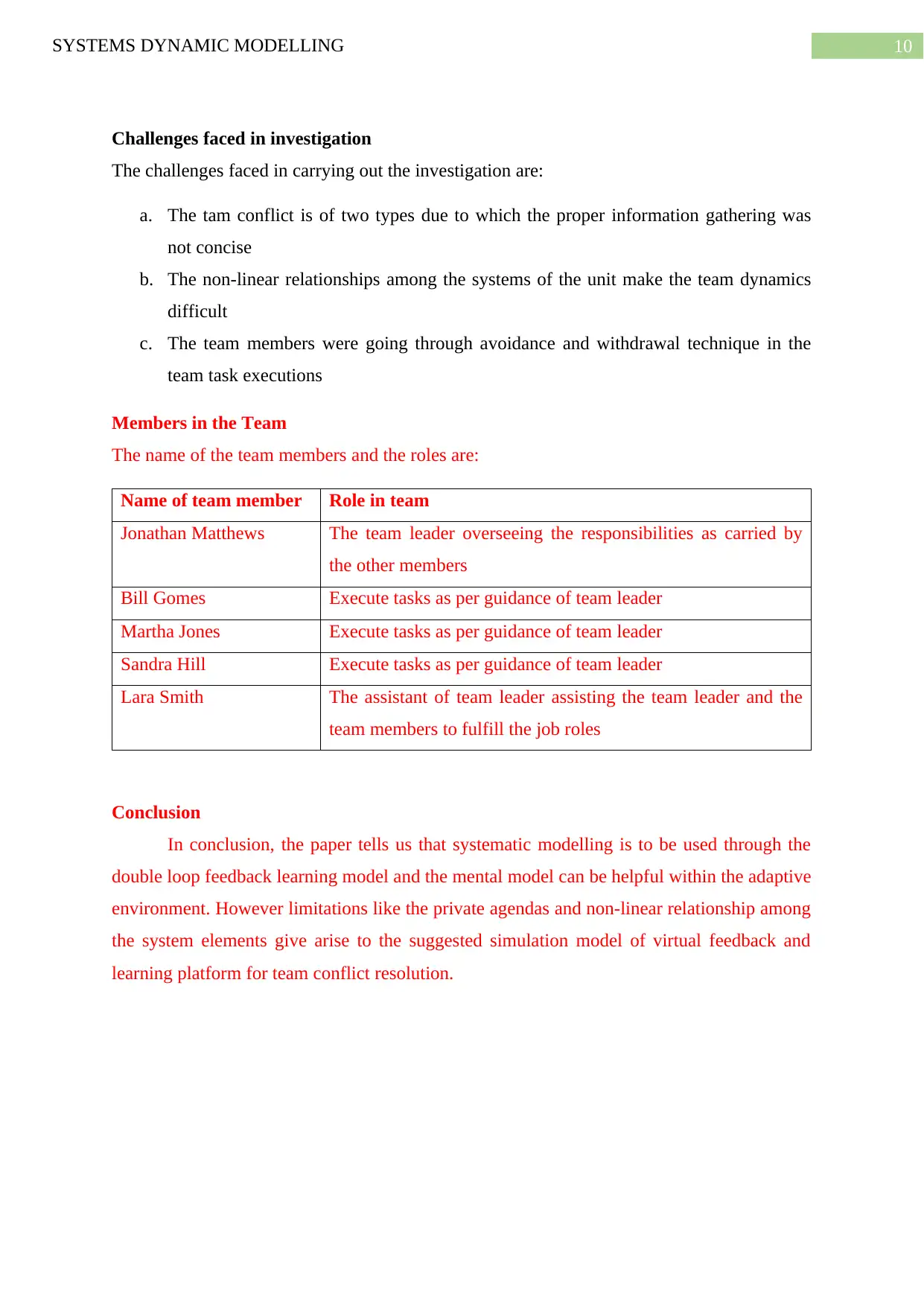
10SYSTEMS DYNAMIC MODELLING
Challenges faced in investigation
The challenges faced in carrying out the investigation are:
a. The tam conflict is of two types due to which the proper information gathering was
not concise
b. The non-linear relationships among the systems of the unit make the team dynamics
difficult
c. The team members were going through avoidance and withdrawal technique in the
team task executions
Members in the Team
The name of the team members and the roles are:
Name of team member Role in team
Jonathan Matthews The team leader overseeing the responsibilities as carried by
the other members
Bill Gomes Execute tasks as per guidance of team leader
Martha Jones Execute tasks as per guidance of team leader
Sandra Hill Execute tasks as per guidance of team leader
Lara Smith The assistant of team leader assisting the team leader and the
team members to fulfill the job roles
Conclusion
In conclusion, the paper tells us that systematic modelling is to be used through the
double loop feedback learning model and the mental model can be helpful within the adaptive
environment. However limitations like the private agendas and non-linear relationship among
the system elements give arise to the suggested simulation model of virtual feedback and
learning platform for team conflict resolution.
Challenges faced in investigation
The challenges faced in carrying out the investigation are:
a. The tam conflict is of two types due to which the proper information gathering was
not concise
b. The non-linear relationships among the systems of the unit make the team dynamics
difficult
c. The team members were going through avoidance and withdrawal technique in the
team task executions
Members in the Team
The name of the team members and the roles are:
Name of team member Role in team
Jonathan Matthews The team leader overseeing the responsibilities as carried by
the other members
Bill Gomes Execute tasks as per guidance of team leader
Martha Jones Execute tasks as per guidance of team leader
Sandra Hill Execute tasks as per guidance of team leader
Lara Smith The assistant of team leader assisting the team leader and the
team members to fulfill the job roles
Conclusion
In conclusion, the paper tells us that systematic modelling is to be used through the
double loop feedback learning model and the mental model can be helpful within the adaptive
environment. However limitations like the private agendas and non-linear relationship among
the system elements give arise to the suggested simulation model of virtual feedback and
learning platform for team conflict resolution.
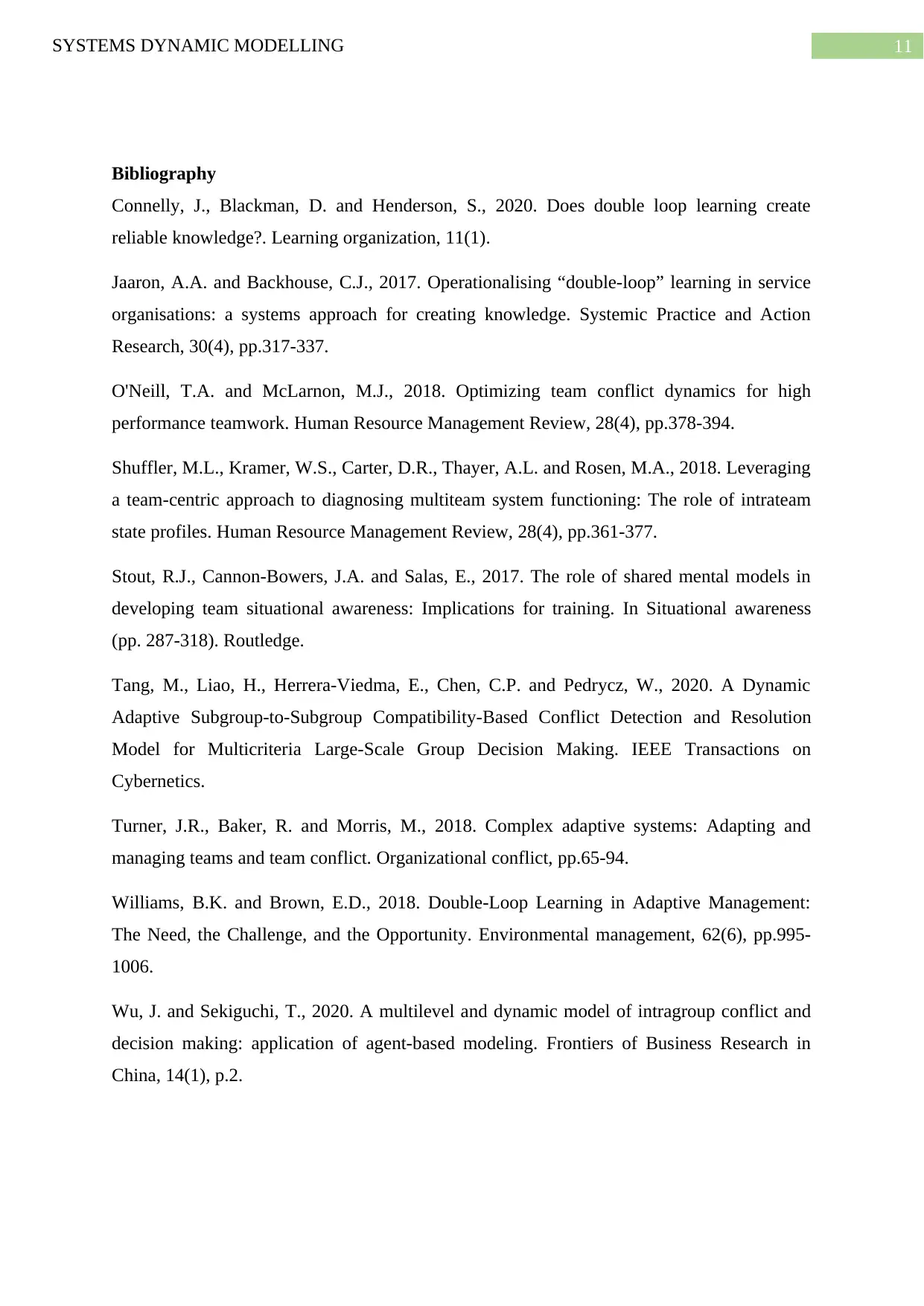
11SYSTEMS DYNAMIC MODELLING
Bibliography
Connelly, J., Blackman, D. and Henderson, S., 2020. Does double loop learning create
reliable knowledge?. Learning organization, 11(1).
Jaaron, A.A. and Backhouse, C.J., 2017. Operationalising “double-loop” learning in service
organisations: a systems approach for creating knowledge. Systemic Practice and Action
Research, 30(4), pp.317-337.
O'Neill, T.A. and McLarnon, M.J., 2018. Optimizing team conflict dynamics for high
performance teamwork. Human Resource Management Review, 28(4), pp.378-394.
Shuffler, M.L., Kramer, W.S., Carter, D.R., Thayer, A.L. and Rosen, M.A., 2018. Leveraging
a team-centric approach to diagnosing multiteam system functioning: The role of intrateam
state profiles. Human Resource Management Review, 28(4), pp.361-377.
Stout, R.J., Cannon-Bowers, J.A. and Salas, E., 2017. The role of shared mental models in
developing team situational awareness: Implications for training. In Situational awareness
(pp. 287-318). Routledge.
Tang, M., Liao, H., Herrera-Viedma, E., Chen, C.P. and Pedrycz, W., 2020. A Dynamic
Adaptive Subgroup-to-Subgroup Compatibility-Based Conflict Detection and Resolution
Model for Multicriteria Large-Scale Group Decision Making. IEEE Transactions on
Cybernetics.
Turner, J.R., Baker, R. and Morris, M., 2018. Complex adaptive systems: Adapting and
managing teams and team conflict. Organizational conflict, pp.65-94.
Williams, B.K. and Brown, E.D., 2018. Double-Loop Learning in Adaptive Management:
The Need, the Challenge, and the Opportunity. Environmental management, 62(6), pp.995-
1006.
Wu, J. and Sekiguchi, T., 2020. A multilevel and dynamic model of intragroup conflict and
decision making: application of agent-based modeling. Frontiers of Business Research in
China, 14(1), p.2.
Bibliography
Connelly, J., Blackman, D. and Henderson, S., 2020. Does double loop learning create
reliable knowledge?. Learning organization, 11(1).
Jaaron, A.A. and Backhouse, C.J., 2017. Operationalising “double-loop” learning in service
organisations: a systems approach for creating knowledge. Systemic Practice and Action
Research, 30(4), pp.317-337.
O'Neill, T.A. and McLarnon, M.J., 2018. Optimizing team conflict dynamics for high
performance teamwork. Human Resource Management Review, 28(4), pp.378-394.
Shuffler, M.L., Kramer, W.S., Carter, D.R., Thayer, A.L. and Rosen, M.A., 2018. Leveraging
a team-centric approach to diagnosing multiteam system functioning: The role of intrateam
state profiles. Human Resource Management Review, 28(4), pp.361-377.
Stout, R.J., Cannon-Bowers, J.A. and Salas, E., 2017. The role of shared mental models in
developing team situational awareness: Implications for training. In Situational awareness
(pp. 287-318). Routledge.
Tang, M., Liao, H., Herrera-Viedma, E., Chen, C.P. and Pedrycz, W., 2020. A Dynamic
Adaptive Subgroup-to-Subgroup Compatibility-Based Conflict Detection and Resolution
Model for Multicriteria Large-Scale Group Decision Making. IEEE Transactions on
Cybernetics.
Turner, J.R., Baker, R. and Morris, M., 2018. Complex adaptive systems: Adapting and
managing teams and team conflict. Organizational conflict, pp.65-94.
Williams, B.K. and Brown, E.D., 2018. Double-Loop Learning in Adaptive Management:
The Need, the Challenge, and the Opportunity. Environmental management, 62(6), pp.995-
1006.
Wu, J. and Sekiguchi, T., 2020. A multilevel and dynamic model of intragroup conflict and
decision making: application of agent-based modeling. Frontiers of Business Research in
China, 14(1), p.2.
⊘ This is a preview!⊘
Do you want full access?
Subscribe today to unlock all pages.

Trusted by 1+ million students worldwide
1 out of 12
Related Documents
Your All-in-One AI-Powered Toolkit for Academic Success.
+13062052269
info@desklib.com
Available 24*7 on WhatsApp / Email
![[object Object]](/_next/static/media/star-bottom.7253800d.svg)
Unlock your academic potential
© 2024 | Zucol Services PVT LTD | All rights reserved.



